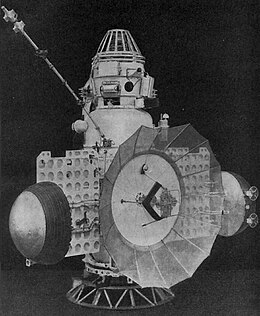|
Zond 3
Zond 3 was a 1965 space probe which performed a flyby of the Moon's far side,[4] taking 28 quality photographs. It was a member of the Soviet Zond program while also being part of the Mars 3MV project. It was unrelated to Zond spacecraft designed for crewed circumlunar missions (Soyuz 7K-L1). It is believed that Zond 3 was initially designed as a companion spacecraft to Zond 2 to be launched to Mars during the 1964 launch window. The opportunity to launch was missed, and the spacecraft was launched on a Mars-crossing trajectory as a spacecraft test, even though Mars was no longer attainable. Spacecraft designThe spacecraft was of the 3MV-4 type, similar to Zond 2.[2] In addition to a 106.4 mm focal length f/8 imaging system for visible light photography and ultraviolet spectrometry at 285-355 μm, it carried ultraviolet (190-275 μm) and infrared (3-4 μm) spectrophotometers, radiation sensors (gas-discharge and scintillation counters), charged particle detector, magnetometer, and micrometeoroid detector.[2][5] It also had an experimental ion engine. Operational historyZond 3 was launched from Baikonur Cosmodrome on July 18, 1965, at 14:38 UTC, and was deployed from a Tyazhely Sputnik (65-056B) Earth-orbiting platform towards the Moon and interplanetary space. This was a repeat of a mission that failed in late 1963 intended to test communication at distances equivalent to the distances experienced by Mars and Earth.[6] Zond 3's lunar flyby occurred on July 20 with a closest approach of 9,219 km (5,728 mi),[2] approximately 35 hours after launch. 25 visible light photographs and 3 ultraviolet spectra of very good quality were taken of the lunar surface, beginning at 01:24 UTC and 11,570 km (7,190 mi) prior to closest approach and ending at 02:32 UTC and 9,960 km (6,190 mi) past closest approach, covering a period of 68 minutes.[2][7] The photos covered 19 million km2 (7.3 million sq mi) of the lunar surface.[8] Zond 3 proceeded on a trajectory across Mars' orbit, but not at a time when planetary encounter would occur. These images were transmitted by radio frequency on July 29 at a distance of 2.25 million km (1.40 million mi). To test telemetry, the camera film was rewound and retransmitted in mid-August, mid-September, and finally on October 23 at a distance of 31.5 million km (19.6 million mi), thus proving the ability of the communications system.[2] The subsequent transmissions were also at progressively slower data rates but higher quality.[6] The mission was ended after radio contact ceased on March 3, 1966, when it was at a distance of 153.5 million km (95.4 million mi).[2][5] It operated for 228 days, roughly equivalent to the time needed to survive a journey to Mars and exceeding that needed for Venus.[2] LegacyIn 1967, the second part of the Atlas of the Far Side of the Moon was published in Moscow,[9][10] based on data from Zond 3, with the catalog now including 4,000 newly discovered features of the lunar far side landscape. [11] In the same year, the first Complete Map of the Moon (1:5000000 scale[12]) and updated complete globe (1:10000000 scale), featuring 95 percent of the lunar surface,[12] were released in the Soviet Union.[13][14] References
External links
|
|||||||||||||||||||||||||||||||||||||||||||||||||||||||||||||||||||||||||||||||||||||||

